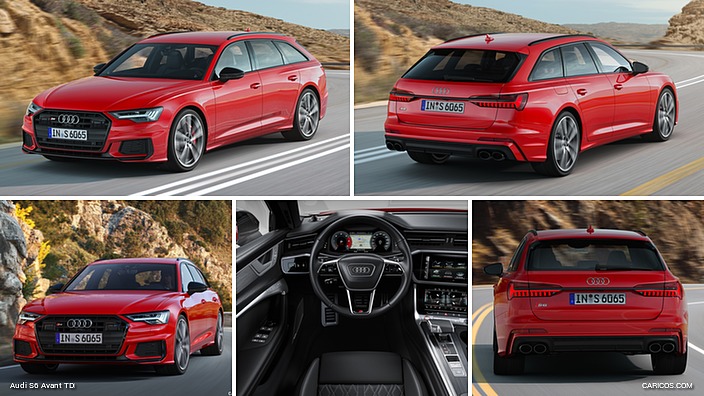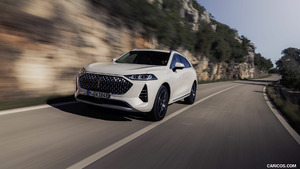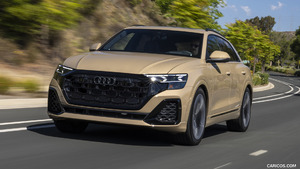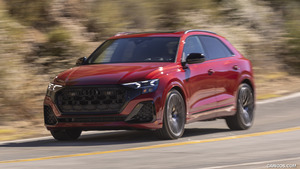2019 Audi S6 Avant TDI
- Performance, presence and comfort – S6 Sedan, S6 Avant and S7 Sportback
- Impressive 700 newton-meters (516.3 lb-ft) of torque thanks to combination of electric powered compressor, 48-volt primary electrical system and V6 TDI engine
- S model design: sporty look and sophisticated pedigree
Sportiness meets efficiency – the new Audi S6 and S7 models make their entrance with a torquey V6 TDI engine, offering customers in Europe the ideal performance models for the long haul. For the first time, Audi has combined an electric powered compressor with a 48-volt primary electrical system. The S sport suspension with damping control, dynamic all-wheel steering and the ceramic brake system tick all the boxes for dynamic cornering and deceleration. The striking design with the sophisticated looks of an S model lends these sporty full-size models particular presence.
- Audi S6 Sedan: Combined fuel consumption in l/100 km: 6.3 – 6.2(37.3 – 37.9 US mpg)*; Combined CO2 emissions in g/km: 165 – 164 (265.5 – 263.9 g/mi)*
- Audi S6 Avant: Combined fuel consumption in l/100 km: 6.5(36.2 US mpg); Combined CO2 emissions in g/km: 171 (275.2 g/mi)
- Audi S7 Sportback: Combined fuel consumption in l/100 km: 6.5(36.2 US mpg); Combined CO2 emissions in g/km: 170 (273.6 g/mi)
* Fuel consumption and CO2 emission figures given in ranges depend on the tires/wheels used as well as the selected equipment
 2019 Audi S6 Avant TDI
2019 Audi S6 Avant TDI
“Torque kick”: electric powered compressor and 700 Nm of torque
The huge torque peaking at 700 newton-meters (516.3 lb-ft) constantly available on demand to the driver across an engine speed range of 2,500 to 3,100 rpm is the ideal basis for performance-minded customers in Europe. The S TDI models offer high driving dynamics and efficiency – an especially attractive combination for long-distance driving. With the S6 and S7 TDI models Audi systematically takes the successful drive concept of the SQ7 TDI (combined fuel consumption 7.6 – 7.2 l/100 km (30.9 - 32.7 US mpg)*; combined CO2 emissions 199 – 189 g/km (320.3 - 304.2 g/mi)* to the next level. For the first time, Audi’s engineers have paired an electric powered compressor with a 48-volt primary electrical system.
This takes the three-liter V6 TDI’s total power output to 257 kW (349 hp). Power transmission is handled by the eight-speed tiptronic automatic transmission, which always operates in tandem with quattro permanent all-wheel drive.
Spontaneous helper: the electric powered compressor
The electric powered compressor delivers high starting performance. As well as very vigorous acceleration, the electric supercharger provides a repeatable boost function when accelerating. This means the EPC pre-empts any hint of turbo lag, and enables high responsiveness and powerful acceleration in every driving situation.
The EPC’s response time is under 250 milliseconds, its peak output is seven kilowatts and its maximum speed is 70,000 rpm. The electric turbocharger’s boost function extends all the way to an engine speed of 1,650 rpm. Thanks to dual supercharging, in other words the EPC working in tandem with the exhaust turbocharger, the full-size S models achieve a constant torque of 700 newton-meters (516.3 lb-ft) across an engine speed range of 2,500 to 3,100 rpm. The EPC supports the TDI’s turbocharger whenever there is insufficient energy in the exhaust gas for a spontaneous torque buildup – when starting off or accelerating at low load, from a low engine speed.
The EPC, which visually resembles a conventional turbocharger, is mounted directly on the engine in the intake air path behind the intercooler. In most operating statuses it is circumvented by a bypass. However if the load demanded by the accelerator is high and the energy available on the turbine side is low, the bypass valve closes, guiding the intake air to the EPC. The compressed air flows directly into the combustion chamber.
The result: spontaneous response and impressive pulling power when accelerating, overtaking and for changes of load. That places the entire power of the 3.0 TDI engine immediately at the driver’s disposal whenever they require it. In everyday driving, the technology avoids frequent downshifts, keeps the engine speed level low and suppresses the turbo lag to which a conventional exhaust turbocharger is susceptible.
The EPC paves the way for an impressive starting performance. The V6-TDI complete with EPC propels the new S6 Sedan from 0 to 100 km/h (62.1 mph) in 5.0 seconds, with the S6 Avant and S7 Sportback taking a tenth of a second longer over the standard sprint. The top speed is electronically limited to 250 km/h (155.3 mph).
“Clean power” – coasting for up to 40 seconds: the 48-volt mild-hybrid system
While the EPC boosts the performance, the mild-hybrid system (MHEV) helps to improve fuel efficiency. The 48-volt MHEV system comprises a belt alternator starter (BAS) and a lithium‑ion battery with a capacity of 10 Ah housed in the vehicle floor beneath the luggage compartment. The BAS is connected to the crankshaft. During deceleration it can recover up to 8 kW of power, which it then stores in the lithium-ion battery. When the driver accelerates again, the BAS reacts instantly by restarting the engine.
MHEV technology allows for start/stop operation from a speed as low as 22 km/h (13.7 mph). Thanks in part to the integration of the mild-hybrid system and the vehicle sensors, the S models realize a fuel saving of up to 0.4 liters in real driving conditions and can coast for up to 40 seconds with the combustion engine deactivated.
On that basis, the S TDI models combine impressive driving dynamics with high efficiency, low fuel consumption and low emissions. All S TDI models have homologation to the Euro 6d temp emission standard. The WLTP values correlate to an NEDC fuel consumption for the Audi S6 sedan of 6.3 or rather 6.2 liters of diesel per 100 kilometers (37.3 or 37.9 US mpg) and CO2 emissions of 165 or rather 164 grams per kilometer(265.5 – 263.9 g/mi), depending on the tires/wheels used. The figures for the S6 Avant are 6.5 liters per 100 kilometers (36.2 US mpg) and 171 g/km (275.2 g/mi), and 6.5 liters/100 km (36.2 US mpg) and 170 g/km (273.6 g/mi) for the S7 Sportback.
Concentrated high tech: the engine
The 3.0 TDI is notable for its power delivery and high efficiency. Its displacement of 2,967 cm3 develops 257 kW (349 hp) of power. Its specific output is 117.9 hp per liter of engine capacity, and its specific torque is 235.9 Nm (174.0 lb-ft) per liter.
The V6 TDI weighs only around 190 kilograms (418.9 lb) and has concentrated high tech to offer in every department. Its common rail system injects fuel at a pressure of up to 2,500 bar. Crankshaft, pistons, connecting rods and oil management meet high-performance requirements, and sophisticated measures have been taken to reduce friction in the crankshaft and camshaft drive. The cooling circuits of the crankcase and cylinder heads are kept separate so that the engine oil warms up rapidly from a cold start – the heads have dual-section water jackets. The coolant flow is directed to the oil cooler, the EPC, the BAS and the compressor case of the turbocharger as needed.
The exhaust turbocharger, with a turbine wheel measuring 50 millimeters (2.0 in) in diameter, generates a relative boost pressure of up to 2.4 bar. Its variable turbine geometry (VTG) is optimized for low-loss flow. The external low-pressure exhaust gas recirculation (EGR) only draws off the exhaust gas after the particulate filter so that the full mass flow can power the supercharger, significantly increasing its effectiveness. Operation of 3.0 TDI is ultra-refined.
Dynamic cornering and high agility: Dynamic all-wheel steering makes its entrance in a S model
As on every S model from Audi, quattro permanent all-wheel drive comes as standard. In normal driving conditions, its self-locking center differential distributes torque between the front and rear axle in a 40:60 ratio. If one wheel encounters slip, most of the drive torque goes to the axle with the better traction. In the extreme, 70 percent can flow to the front wheels and 85 percent to the rear wheels. For sports driving, wheel-selective torque control enhances sporty handling: It brakes the two wheels with reduced load on the inside of a bend slightly before they lose grip.
The standard-fit progressive steering already comes with sports ratios in its basic configuration; the greater the steering lock, the more direct the steering is. Its S-specific electro-mechanical servo assistance filters out disagreeable bumps but communicates useful information to the driver.
Compared with their predecessor models, the new large S models offer even better transverse dynamics. On request, Audi can supply dynamic all-wheel steering – this combines dynamic steering with a variable ratio of 9.5:1 and 16.5:1 at the front axle with separate rear-axle steering that is operated by spindle drive and track rods. At speeds up to 60 km/h (37.3 mph), the rear wheels turn as much as five degrees in the opposite direction to the front wheels. This reduces the turning circle by up to 1.1 meter (3.3 ft). At medium and high speeds above 60 km/h (37.3 mph), they are turned by as much as two degrees in the same direction as the front wheels. This makes the S models much more maneuverable and agile at low speeds, and provides more directional stability at high speeds and when changing lanes.
The S sport suspension developed specially for the new S models comes with damping control as standard, highlighting these vehicles’ sporty character. It lowers the body of the S6 by 20 millimeters (0.8 in), and by 10 millimeters (0.4 in) in the case of the S7. This gives both S models the same low ride height. Adaptive air suspension – the air suspension version with adjustable damping – makes its first appearance on S models as an explicitly comfort-oriented alternative. It can be set to three modes and includes a “lift” position for poor roads and automatic leveling. In the “auto” mode the body is lowered by a further 10 millimeters (0.4 in) at speeds of 120 km/h (74.6 mph) upwards, and in the “dynamic” mode the vehicle remains always at this low ride height.
For even sportier road behavior, quattro drive can be supplemented with the sport differential on the rear axle. On bends taken dynamically, the sport differential veritably pushes the car into the bend, producing a high level of agility. The driver can adapt the sport differential’s control strategy via Audi drive select. The sporty road behavior is also aided by the five-link-design axles, which are made largely from aluminum. Two subframes connect the links with the vehicle body – the elastokinematics are firmly tuned.
All chassis components are controlled by the electronic chassis platform (ECP). It coordinates the shock absorbers’ action at intervals of milliseconds. The ECP collects comprehensive information about the movement of the car and the data from the chassis control systems involved. From these, it calculates and precisely coordinates the optimal function of these components in an integrated handling controller. Drivers of the new S models experience this progress in the form of precise handling and high transverse dynamics. As well as the dampers, the EPC controls the dynamic all-wheel steering and sport differential. The driver can configure the effect of these modules in the Audi drive select dynamic handling system. It comes with an S-specific setup and offers the diverse modes “comfort”, “auto”, “dynamic”, “efficiency” and “individual.”
Strong support: the optional ceramic brake system
The six-piston brakes on the new S models are big on performance. Their calipers are made from aluminum, painted black (or optionally red) and adorned with S logos. At the front, six pistons on each wheel grip steel brake discs measuring 400 millimeters (15.7 in) in diameter; the rear discs measure 350 millimeters (13.8 in) across. As an option, Audi can fit a six-piston ceramic brake system made from light, abrasion-resistant carbon fiber ceramic with 400 millimeter (15.7 in) discs at the front and 370 mm (14.6 in) discs at the rear. The complete ceramic brake system weighs nine kilograms (19.8 lb) less than its steel counterpart, so it significantly reduces unsprung masses with the effect of further enhancing driving dynamics, especially when cornering. Electronic Stabilization Control ESC provides even more precise control than in the previous model. The driver can switch it to a Sport mode or shut it down completely.
The new Audi S6 Sedan, S6 Avant and S7 Sportback are fitted with 20-inch wheels with 255/40 tires as standard; 21-inch versions are optionally available. Torus absorbers – foam layers bonded into the tires – eliminate annoying droning frequencies so that these tires provide high acoustic comfort despite their size. In conjunction with the wheel range available from Audi Sport GmbH, 20-inch Performance tires can be ordered for even better grip and handling characteristics.
Presence: the design of the S models
The S models are characterized by their striking, distinctive design and sophistication – outside and inside alike. The new Audi design language further emphasizes their even more sporty look. A dynamically styled front trim, wide sills and a wide rear diffuser with four tailpipe trims infuse the S models with on-road presence. Distinctive S trim elements in dark chrome and aluminum on the radiator grille lamellas, the front blade, the side air inlet, the exterior mirrors and the rear diffuser proclaim their sporty characteristics at a glance.
On the S6, the horizontal splitter in aluminum look creates an enormous feeling of width at the front. It links the two air inlets and ends with the two winglets at the air ducts. At the rear, the S6 features an integrated spoiler that visually extends the trunk lid, subtly emphasizing its sportiness. Aluminum applications in the diffuser link the four S-specific tailpipe trims. These also underline the width of the vehicle.
On the S7, the wide, low Singleframe grille features lamellas in aluminum standard and a corpus in dark chrome matt. The air inlets are enlarged, with very bold contours, and their honeycomb-structure inserts come in titanium black. The blade running through them is in a gleaming aluminum look, as are the exterior mirror housings in aluminum. Other features that distinguish the four-door coupé from the S6 models are the funnels in the air inlets and the angular trim strips on the side sills.
Side-on, the sporty appearance of all three cars is enhanced by the large wheels, which are typical features of the S models. A diffuser insert in dark chrome matt adds the finishing touch to the lower rear end. The four tailpipe trims are in gleaming chrome.
“Designer loft”: interior design with sporty-sophisticated aesthetics
Inside, the typical S model look awaits the driver: black color schemes, sophisticatedly sporty inlays, color-contrasting stitching as well as model-specific equipment details that ramp up the sporty driving experience even further.
The seats range, too, underlines the sporty overall impression. As well as the sport seats with embossed S logo, customers who want an overtly sporty style can choose highly contoured S sport seats with integrated head restraints, embossed S logo and rhombus pattern. For out-and-out comfort, Audi offers multi-adjustable customized contour seats optionally with ventilation and massage. The seat upholstery, always with contrasting stitching, is available in a combination of leather and Alcantara or in the Valcona top-end leather grade. Customers have a choice of the colors black, rotor gray and arras red. A variety of leather packages are available for customizing the interior further. Instead of the standard inlays in brushed aluminum, fine grain ash is available as an option. Other S-specific equipment details include a dedicated graphic layout of the standard-fit Audi virtual cockpit with rev counter flashed up centrally. Another option is a steering wheel with flat-bottomed rim. The footrest and pedal caps are in stainless steel, and when the driver climbs in they are greeted by illuminated aluminum sill trims with S logo.
Perfectly equipped for long distances: the comfort equipment
With the S6 Sedan, S6 Avant and S7 Sportback, Audi offers a sporty full-size model for every purpose: the classic Sedan, the practical Avant or the four-door Coupé. All models come with comprehensive comfort, connectivity and driver assistance equipment. As such, they expertly blend sportiness with long-distance capability.
Compared to the product line’s A models, the S models come with an extended range of standard equipment: This includes 20-inch rims in an S-specific wheel design, or MMI navigation plus including Audi virtual cockpit with 12.3-inch display. As a standard feature there are also Alcantara sport seats in the S6 and super sport seats in the S7. Four-zone automatic air conditioning completes the standard specification.
The new Audi S models are excellent cars for long-distance driving – among other reasons thanks to their rigid body structure which largely suppresses noise interference, their advanced aerodynamics and aeroacoustics, as well as their spacious interiors and luggage compartments. Depending on body version, the latter have a capacity of 530 liters (18.7 cu ft) (S6), up to 1,390 liters (49.1 cu ft) (S7 Sportback) and up to 1,680 liters (59.3 cu ft) (S6 Avant).
The new large S models will be making their debut in European markets in summer 2019. The starting prices in Germany are: EUR 76,500 for the S6 Sedan, EUR 79,000 for the S6 Avant and EUR 82,750 for the S7 Sportback.
For the United States, Asia and Middle East: the S6 and S7 models with 2.9 TFSI
In overseas markets – to reflect local customer preferences and driving profiles – the S6 and S7 will be available as the 2.9 TFSI with an output of 450 hp and 600 Nm (442.5 lb-ft) of torque. Like the TDI models, the V6 gasoline version will be equipped with both the EPC and the 48-volt MHEV system, for more performance and efficiency.
The equipment, data and prices stated here refer to the model range offered for sale in Germany. Subject to change without notice; errors and omissions excepted.











